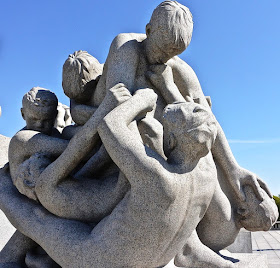I was lucky to visit this park in May 2018, and therefore am very pleased to share some pictures and information about the key elements and sculptures in this park. Several distinct areas are filled with sculptures, like the bridge, 100 m long, with 58 bronze sculptures, representing human relationships.
Or the gigantic fountain, supported by several men, which express the link between humanity and nature. I also liked the other sculptures, humans almost inside trees, all around the fountain.
Several magnificent gates in wrought iron welcome the visitors, as well as other metal sculptures like the sundial, visible either in the park, or inside his museum.

The 'Wheel of life' : as mentioned in the Vigeland park website (see the link in 'Sources' at the end of this post) this sculpture sums up the dramatic theme of the entire park: Man's journey from cradle to grave, through happiness and grief, through fantasy, hope and wishes of eternity'.
The nearby Vigeland museum holds maquettes of his projects, as well as his plaster models. Indeed he often designed and modelled his idea in plaster, before asking stone carvers to realize his projects.
Gustav Vigeland, born in 1869, had a schildhood surrounded with craft among his family, and went to Oslo to learn woordcarving. Later, he decided he wanted to be a sculptor, and, once aged 22, travelled to Paris, where he attended sculpture classes in Rodin workshop, went also to Florence, Copenhagen and Berlin.
He also worked for the restoration of the famous Nidaros catheral, in the previous Norwegian capital, Trondheim. He probably adopted one of his themes, the dragon, at that time, being in close contact with medieval art.
Sources
Wikipedia
Vigeland.museum
Video 1 - by Gay Travellers magazine
Video 2 - by Vigeland museum






















